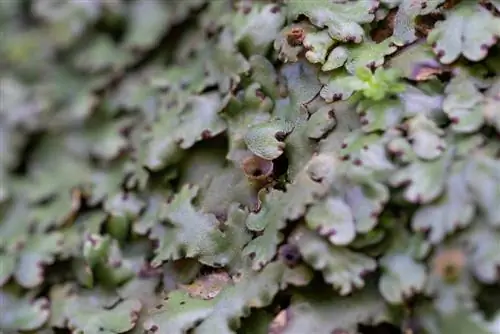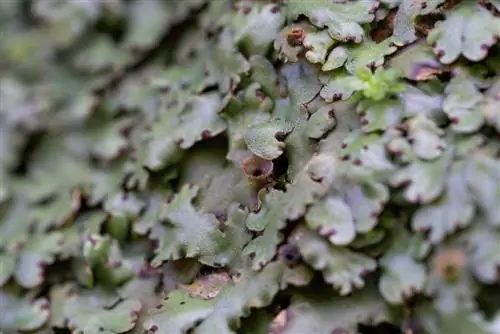- Author admin [email protected].
- Public 2023-12-16 16:46.
- Last modified 2025-06-01 06:02.
Read a commented profile about liverwort and its uses here. You can find out how to make liverwort extract yourself and use it correctly here.

What is liverwort used for?
Liverwort is a group of over 10,000 rootless spore plants found worldwide. They are used for plant tonics, pest repellents, household cleaners and natural remedies. Liverwort extract can be purchased or made yourself and used for various purposes.
Profile
- Scientific name: Marchantiophyta
- Department: Land Plants
- Moss family: Liverworts with 10,000 species
- Occurrence: worldwide
- Growth type: rootless spore plant
- Growth height: 1 mm to 15 cm
- Plant body (thallus): fleshy, roundish
- Growth habit: ground cover
- Status: Weed, plant tonic, natural medicinal plant
Moss clan
Livermoss, with more than 10,000 species, represents the largest of three moss families from the land plants department. A further 6,000 to 8,000 known species of moss are classified as broadleaf mosses (Bryophyta) and hornworts (Anthocerotophyta).
The name liverwort refers to the liver-shaped plant body of fountain liverwort. In the Middle Ages, the moss was used as an extract boiled in wine to treat liver problems. The term was later applied to the entire clan. Liverworts have no roots, very rarely leaves or flowers and are often overgrown by other land plants. Nevertheless, the tiny green plants have stood their ground bravely against all the vicissitudes of evolution for more than 400 million years. Whether shade, wet or dry - liverworts grow relentlessly and rapidly, as the following video demonstrates.
Video: Beautiful liverwort - growth in fast motion
Status
For a long time, liverwort was reduced to the status of an annoying weed. Nature-oriented hobby gardeners respect liverwort as an important component in the ecosystem. Among other things, the garden's beneficial insects find a place to retreat here and birds collect moss cushions as nesting material.
In natural gardens, an extract from liverwort has earned a good reputation as a plant strengthener because it helps against various pests. Additional environmentally friendly functions make liverwort extract a popular natural remedy in the home and horse stable.
Liverwort extract
Livermoss extract is a purely natural product with a high-dose combination of active ingredients from the best moss species in this group. Produced as an essence with 70 percent alcohol, the natural active ingredients are particularly effective, decompose quickly and leave no harmful residues in the soil. Read many tips about use, purchasing sources and making your own liverwort extract in the following sections:
Usage
The following table provides an overview of the wide range of environmentally friendly uses for the garden, household and he alth:
| Plant strengtheners | Pest repellent | Natural household product | Natural remedies (external use) |
|---|---|---|---|
| preventive against mildew | Snails | Cleaning agents for mold | he althy for nail fungus |
| effective against mold | Mosquitoes | Impregnation against fungal infestation | for fungal diseases on horses |
| for fungal infestation on roses (star sooty mildew) | Ticks | Natural additives in animal care |
Application tips
For the correct use of liverwort extract, please pay particular attention to the following instructions:
- Prepare plant strengthening agent: Stir 5 ml extract into 1 l water.
- Use preventatively: spray crops and ornamental plants until they are dripping wet every 10 to 14 days.
- Harmless: aerial parts of root and tuber vegetables can be sprayed and eaten later.
- Wash raw food: wash treated raw food (fruit, salad) before consumption.
- Prepare cleaning agent: Add 10 ml of liverwort extract to the cleaning water or spray diluted with 100 ml of water.
- Fungal diseases in horses: Fill 10-20 ml extract with 100 ml water into a spray bottle and apply.
For the treatment of plants, surfaces and objects already infected with fungal pathogens, the concentration can be increased to up to 20 ml. It is important to note that liverwort extract must not be used internally. Regular foot baths have proven to be effective for treating nail fungus. For this purpose, dissolve 20 ml of liverwort extract in 5 liters of water. For external use in pet care, 10-20 ml of extract is added to 100 ml of water.
Buy liverwort extract
Liverwort extract has long since shaken off its reputation as an organic niche product. Today you can buy the natural extract in many places in local stores and online shops:
- At Jean Pütz, the pioneer of liverwort extract: jean-puetz-produkte.de
- Pharmacies and drugstores: on site and online.
- Amazon and Ebay.
- Specialist retailer for natural cosmetics, plant care, animal care, horse supplies.
Make your own liverwort extract
In the hobby garden, the motto is: Doing it yourself is the key. According to this motto, you can also produce liverwort extract yourself using this recipe:
- Collect liverwort in the lawn and garden bed, in stone joints or on potting soil.
- Wash moss pieces and dry in a dark, airy location.
- Crush 10 g of dried moss in a stand mixer.
- Add 100 ml alcohol (50% to 70%) and puree.
Depending on the use, the extract is diluted with rainwater or distilled water. Let the essence steep for a day and then filter out the moss residue.
Excursus
Smoking liverwort - is that possible?
The news hit like a bomb: You can smoke liverwort like cannabis. Researchers found that various liverworts produce cannabinoids with a chemical structure similar to THC. Current studies are investigating whether liverwort can actually replace THC in the future.
Planting liverwort
Hobby gardeners plant liverwort as a green design component in the garden or for the production of extract. You can buy young liverwort in specialist stores or on Amazon. It is permitted to collect liverworts in the forest in small quantities without coming into conflict with the strict nature conservation law. You can find out where and how to plant liverwort skillfully in the following sections:
Location
Liverwort finds ideal growing conditions in these locations:
- Partially shaded to shady location with high humidity, for example near water.
- Moist, nutrient-poor clay soil, often compacted and with regular waterlogging.
- Preferably acidic pH value less than 5, 5.
Propagate
You only need a small amount of purchased or collected liverwort for planting. You can easily propagate the rootless spore plants. To plant one square meter of bed area, just 5 pieces of 10-12 centimeter moss patches are sufficient. Within a short time, a dense, ground-covering carpet forms. The following short instructions explain how to plant liverwort correctly:
- The best planting time is from April to September at 15° to 20° Celsius or warmer.
- Weed the bed area, rake it, smooth it out finely with a rake and water it.
- Cut the liverworts into small segments.
- Create small planting holes with a diameter of 2 cm to 3 cm at a distance of 5 cm to 8 cm in the bed.
- Place pieces of moss in the holes with tweezers or fingers, press down the soil and water with a fine spray.
Care for liverwort
The care of liverwort is limited to regular watering in dry conditions. Please use mostly soft rain or pond water so that the pH value does not rise. The moss cannot be fertilized. Once freshly planted liverwort has formed a dense carpet, weeds are effectively suppressed. Until then, daily weeding is recommended.
Fight liverwort
Liverwort is not always a welcome guest. Sometimes the green cushions in the garden spread uncontrollably and live up to their reputation as weeds. How to fight liverwort without chemicals:
- In the bed: rake regularly, loosen up and incorporate sand.
- In the lawn: scarify and sand twice a year, aerate once a year.
- Limen: test the pH value annually and, if necessary, lime the bed soil or lawn.
Liverwort is a tough opponent on pavement. Fight the moss on insensitive surfaces with a high-pressure cleaner or flamer. First remove liverwort from natural stone with a sponge or wire brush. Then destroy any remaining moss with vinegar.
Popular varieties
Among more than 10,000 species of liverwort, there are many variations for the nature-oriented hobby gardener to discover:
- Fountain liverwort (Marchantia polymorpha): most famous liverwort with rounded plant body and conspicuous breeding cups on the surface.
- Bare fruit moss (Porella): beautiful liverwort with distinctively feathery growth that also grows on stones.
- Whip moss (Bazzania trilobata): leafy liverwort with elongated flank leaves up to 10 cm long.
- Star liverwort (Riccia fluitans): popular liverwort for ponds and aquariums that thrives floating or submerged.
FAQ
What helps against liverwort?
Does liverwort in the bed give you a green headache? Then make life miserable for the mossy weeds by raking and weeding regularly. Due to the unrest in the bed, rootless liverworts cannot grow and give in. Annual scarification and sanding of the lawn helps prevent moss infestation. If the pH value is acidic below 5.5, you should lime mossy green areas to a value that is hostile to moss between 6 and 7.
How to use liverwort extract for a horse?
Stubborn fungal diseases in horses are rampant in boarding stables. Cleaning equipment, h alters, blankets and saddles are loaned out in a friendly manner. In this way, pests spread freely. The chemical-free treatment with liverwort extract is considered an insider tip among riders. Mix 20 milliliters of extract with 100 milliliters of water and pour the solution into a spray bottle. If affected skin areas are sprayed regularly, significant relief of symptoms can quickly be seen.
Can you smoke liverwort like THC?
Liverwort has been offered as a so-called legal high since the 1990s. At that time, Japanese researchers discovered that liverworts are capable of producing cannabinoids whose chemical structure is very similar to the well-known THC. According to a study by the University of Bern, liverwort cannabinoids reach the brain just as quickly as THC and trigger a psychoactive effect. Of course, the findings are based on animal models. Solid basic research is needed to provide robust evidence that liverwort can actually produce THC-like effects in humans.
What does liverwort do to people?
In humans, liverwort extract is said to have a beneficial fungicidal effect on fungal diseases. Daily hand and foot baths are recommended for the treatment of nail fungus. Alternatively, soak a cotton ball in liverwort extract and dab the affected skin areas three times a day.
Can you use liverwort extract internally?
No, liverwort extract is only suitable for external use. This premise applies equally to humans and animals.
Which liverwort can I plant in a small aquarium?
Delicate liverwort (Monosolenium tenerum) is perfect for planting in mini aquariums. The moss is closely related to fountain liverwort and is just as undemanding. With a maximum growth height of 2 centimeters, delicate liverwort is only half as large as the well-known pond liverwort. Display the moss in the aquarium decoratively by tying it to a root.






